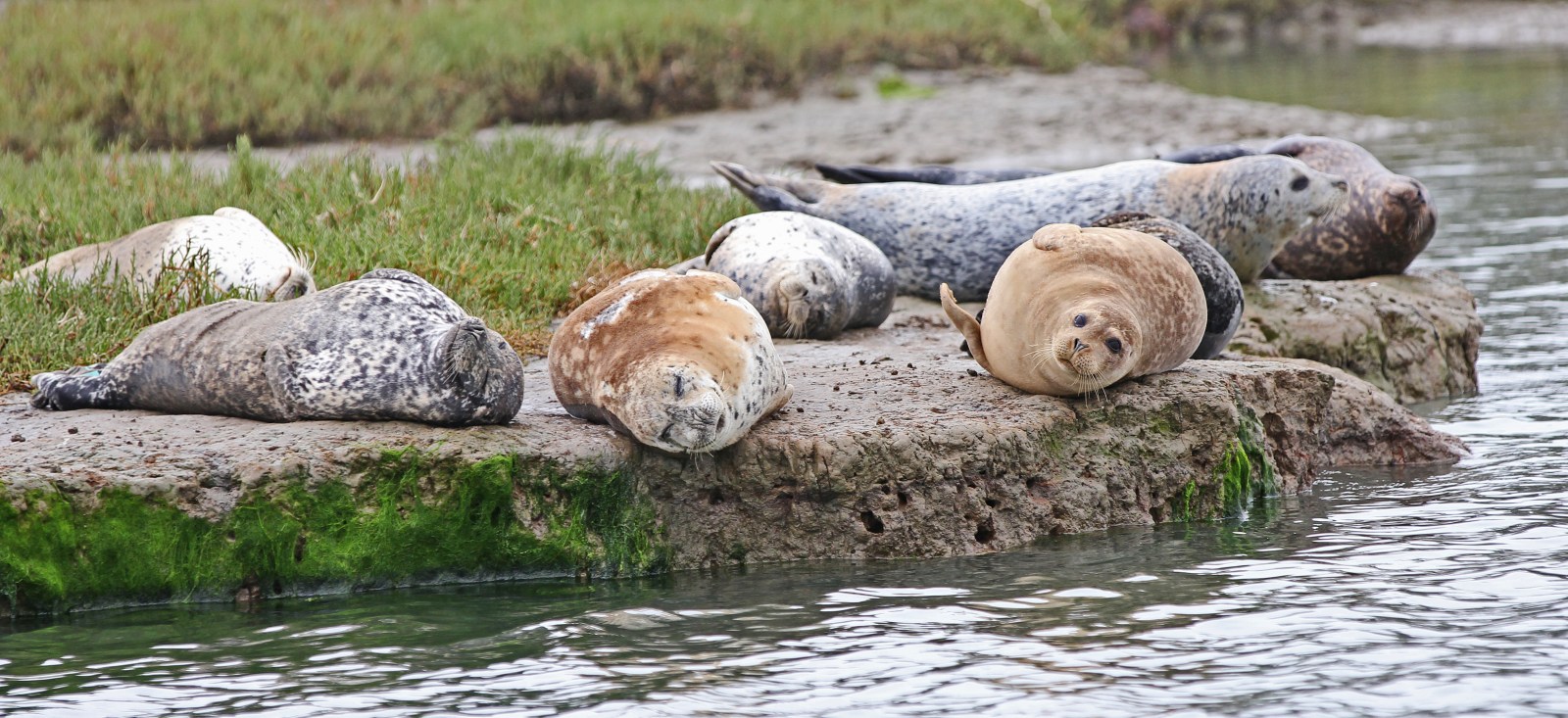Ivano Aiello trudged through marshy banks of Elkhorn Slough in Monterey on January 21st to collect samples from the soil’s surface and subsurface, 3 to 5mm deep, as he’s done for over a decade. This time, charred plastic debris littered the ground. Chunks of concrete lay scattered in pieces among mats of pickleweed. Five days earlier, a fire broke out about a mile away at Vistra Moss Landing Power Plant, the world’s largest lithium-ion battery storage facility, according to the company. The smell of fire was gone, but he wondered what lingered in the soil.
Aiello took about thirty samples along the main channel of the marsh over the course of a few hours, and returned to his microscope at San Jose State University’s Moss Landing Marine Lab (MLML), where he is department chair and a professor of marine geology. Out of the nearly 40 elements he detected in this quick sample, three elements—nickel, manganese, and cobalt—showed dramatic increases. When he typed the elements into his search bar, an ad for 300-dollar lithium batteries popped up. “That’s what I’m looking at,” he thought to himself.


Moss Landing Power Plant overlooking the sea otters at Elkhorn Slough (kqedquest via Flickr ^(https://www.blogquicker.com/goto/https://www.flickr.com/photos/kqedquest/361194518/in/photolist-xVdxG-fFmbTU-23eGVNo-nYo7Rm-FU7SY-2aTkHVp-5N9D1w-6teqjy-73Rzmg-7RD8Pk-28FGgJm-YaWdS-MpCYBn-7RD8NK-26R9XFR-6tek73-caWtuh-TVC77Y-6teRSS-caWPv9-caWQ71-77656T-nYo7NL-YaWcG-6taC6i-6tehGo-smjwNV-8STVRA-caWN73-nYnmcj-Qfhamo-6tePhw-7fqCsP-86R1YE-3YDzHp-fFmaqU-caWwjE-SFzQNq-caWNsY-Mmum1m-nYtWZg-2iuTetv-nFZkpK-nG1jrZ-b3c24p-SpJusx-nFZzmS-7fqCLp-fF4ACR-3YDzU8%20kqedquest%20CC%20BY%20NC%202.0), CC BY NC 2.0); Elkhorn Slough aerial view (NOAA/Elkhorn Slough National Estuarine Research Reserve via Flickr ^(https://www.blogquicker.com/goto/https://www.flickr.com/photos/usoceangov/9684987773/in/photolist-fKQ6rP-rv5Hzr-QXMnz6-6tea27-Mmukqd-fhHtMC-6UuRqp-2jJi2N6-xVdxG-fFmbTU-23eGVNo-nYo7Rm-FU7SY-2aTkHVp-5N9D1w-6teqjy-73Rzmg-7RD8Pk-28FGgJm-YaWdS-MpCYBn-7RD8NK-26R9XFR-6tek73-caWtuh-TVC77Y-6teRSS-caWPv9-caWQ71-77656T-nYo7NL-YaWcG-6taC6i-6tehGo-smjwNV-8STVRA-caWN73-nYnmcj-Qfhamo-6tePhw-7fqCsP-86R1YE-3YDzHp-fFmaqU-caWwjE-SFzQNq-caWNsY-Mmum1m-nYtWZg-2iuTetvNOAA), CC by 2.0)
The fire at Vistra Moss Landing Power Plant, owned by Texas-based Vistra Energy, started January 16th and burned for three days, consuming 75 percent of the plant and its 100,000 lithium-ion cells. These rechargeable batteries store excess solar energy during the day, and deliver it to the grid at night, or on less sunny days. Heavy metals like the ones Aiello identified are often used in these batteries because of their ability to store large amounts of energy.
But these heavy metals are quite lightweight and travel far. The fire released contaminants that ended up at least two miles away, settling over the water and soil at Elkhorn Slough, the country’s first estuarine research sanctuary and home to 700 species, several of which are threatened and endangered.
Aiello returned with his team, collecting 100 soil samples within a two-mile radius of the plant over the course of nearly three days. Nickel, manganese, and cobalt were present at concentrations hundreds to thousands of times greater than when he last measured them two years ago. Now, his laboratory, nonprofits, and public agencies are rushing to figure out what this means for the rest of the slough.
The metals “might start interacting with the environment,” says Aiello. “What we need to study is whether they will become bioavailable”—whether they will absorb into the plant and animal tissues of life at the slough.
A pair Brandt’s Cormorants camping on their nest (Jan Arendtsz via iNaturalist ^(https://www.blogquicker.com/goto/https://www.flickr.com/photos/janarendtsz/14017881051/), CC by ND 2.0); a single Lewis’s Moon Snail attached to a rock (nature1111 via iNaturalist ^(https://www.blogquicker.com/goto/https://www.inaturalist.org/photos/112243781?size=original), CC BY NC); and a squinting sea lion at Elkhorn Slough (Michael Kaufman via iNaturalist ^(https://www.blogquicker.com/goto/https://www.inaturalist.org/photos/444843461?size=original), CC BY-NC-ND)
Land meets the sea at Elkhorn Slough, a seven-mile stretch of water and wetland from Moss Landing to Watsonville, home to California’s largest concentration of southern sea otters—about 150—and the state’s second largest estuary. The flows of water between Monterey Bay and estuary creates opportunities for a diversity of salt and freshwater-loving species living among intertidal marshes, mudflats, oyster communities, and eelgrass beds, protected from harsh ocean waves. A hundred species of fish including bat rays and leopard sharks swim in its channel; 550 species of invertebrates like oysters and moon snails plant themselves on rocks and mud; hundreds of harbor seals and sea lions flank its docks and shores. The slough inhabits endangered species like the California brown pelican, California least tern, Santa Cruz long-toed salamander, and American peregrine falcon. “It’s very essential habitat,” says Aiello. “It’s one of a few wetlands in California.”
Before it was a preserve, Elkhorn Slough was a hub of fishing and farming. Farmers drained water from the slough to grow crops in the 1900s; the U.S. Army Corp of Engineers began dredging the mouth of the estuary every three years to make way for bigger ships in the 1940s. About half of the tidal marsh in the slough has been lost since then. Conservation didn’t begin until 1971, when The Nature Conservancy began purchasing wetlands to protect the slough from major development. In 1979, the National Oceanic Atmospheric Association (NOAA) established it as an estuarine preserve owned and managed by the California Department of Fish and Wildlife (CDFW). Three years later, the Elkhorn Slough Foundation was established as a land trust and partner with NOAA and the CDFW. Since then, it has acquired and protected more than 4,200 acres—making it the largest landowner in the watershed.
As conservation accelerated, a PG&E power plant facility was also developing at the mouth of the slough. Marked by two 500-foot steam towers visible from Highway 1 and nearby farms, the plant began commercial operation in 1950—equipped with gas-powered turbine and steam generators cooled by ocean water. The plant changed hands among power companies a few times before Vistra Energy merged with previous owner Dynegy Moss Landing in 2018, becoming Moss Landing Power Company in 2020. While using much of the same infrastructure, the plant presented a way to store renewable energy for future use.
“I think there was actually quite a bit of enthusiasm on the part of the community,” says Mark Silberstein, the executive director of the Elkhorn Slough Foundation. The plant presented a “way to store wind and solar power during peak production, when otherwise it would be wasted.”


Moss Landing Power Plant, just under mile north of the Moss Landing Marine Laboratory (Steve Ryan via Flickr ^(https://www.blogquicker.com/goto/https://www.flickr.com/photos/juniorvelo/32030897466/), CC by SA 2.0); Elkhorn Slough marshland (Hazel Rodriguez/USFWS via Flickr, ^(https://www.blogquicker.com/goto/https://www.flickr.com/photos/usfws_pacificsw/45073478002/in/photolist-2bEZmF5-MLHCLL-8YBCjd-MPJeVz-MLHEM9-LSeZ8d-MLHxi1-LSeY99-LSeZgj-MLHw8L-MLHCoG-MLHFpw-MLHuC1-MLHKJo-MLHEzW-MDDQ3u-LSeYP7-MLHwPA-MLHvdE-MLHwCy-MLHuN1-MLHJYA-MLHEpW-9USiJM-MLHvXW-MLHyds-MLHyWw-2qriMGB-MLHv6q-MLHJB3-2mMCZTC-MLHEYm-2bKiG7i-MLHxtG-T53qDj-TN7Jfb-MLHBzN-2bEYHc7-7ZFjyb-MLHy5m-28Z2Saf-PBjN63-2amJXkp-2mMDi2L-2bEYRry-2aDCK6U-2amJUNF-MZhSNM-2amK7nc-2aDCU4o) Public Domain)
Lithium-ion battery plants, however, also pose dangers: fire, explosions, and toxic plumes and runoff. Overheating begins with thermal runaway, a phenomenon in which lithium-ion cells start uncontrollably heating up. While the heat should be able to escape from the cell, with damage, improper design, or a short circuit, the cell can generate heat faster than it can dissipate. Heat and pressure build in the battery, leading to fire and explosion, releasing gases like carbon monoxide, carbon dioxide, methane, and ethane. Fire ensues.
The Moss Landing Power Plant was no exception to these risks. After a couple of incidents of battery meltdowns and overheating, since the plant began operating in 2019, a fire erupted. Over 1,200 people were temporarily evacuated; Highway 1 closed for three days.
Vistra’s overheating response system is designed to inject water directly onto the batteries to cool them off, and was working when the fire department arrived, says North County Fire Protection Department fire chief Joel Mendoza. But a few hours after the fire began, it escalated—quickly. “I think we made the right call by backing [the firefighters] out,” says Mendoza. “It was just too much fire for anybody to handle at that point.” Because the batteries were sealed, the fire department could not do much to suppress the fire, other than wait. “Imagine batteries burning inside a refrigerator,” says Mendoza. “You’re spraying water on the outside… but the battery is still burning inside.”
A blaze this big was unexpected for local officials. Vistra’s emergency response plans are “not designed for entire facility to go up like that,” says Mendoza, and “did not account for a fire of this size,” wrote Monterey County supervisor Glenn Church in an email.
“It is not hyperbole to call this worst-case or even beyond a worst-case scenario,” wrote Church. “The flames went up to 250 feet, or about halfway up the stacks. There was smoke for about two days.” The cause of the fire still remains unknown, according to the county. The evening of the fire, at the request of Monterey County, the EPA installed nine monitoring stations within the area of evacuation to test for hydrogen fluoride, a highly toxic gas produced by lithium-ion battery fires, and particulates from combustion. Neither contaminant was detected at levels that cause concern for human health, according to the EPA’s statement in a press conference two days after the fire, though Monterey County citizens were left with headaches, nosebleeds, and metallic tastes in their mouths.

Whether contamination reached soils remained an open question. In the meantime, the CDFW began preparing for the worst. “Out of an abundance of caution, CDFW is modifying activities that disturb soil and vegetation,” says Krysten Kellum, a CDFW spokesperson. Kellum did not provide comment, however, on what these activities entail.
Nonetheless, Aiello decided to conduct soil testing himself, as soon as the evacuation orders were lifted for his laboratory.
“I was curious, because we just had a giant fire next door,” he says, at a battery plant he did not realize could emit toxic chemicals. “It was completely off my mind,” Aiello says. “My life was focused on completely different things than heavy metals.”
For the past decade, Aiello has been studying soils at restoration sites in Elkhorn Slough, measuring grain size, moisture content, and soil composition. When Aiello introduced elemental analysis into his studies in 2023, he began building a baseline of data for future comparisons—handy for measuring the impacts of disaster. After the fire, he went back to his survey sites: 100 locations in various upland, riparian, and marsh environments. “What we’re finding is that there’s a variability within the area,” he says. “But it’s all high, maybe much higher, in some cases.”
Though he has yet to complete his investigation, he has already noticed some patterns. “The highest concentration seems to be occurring where the wetlands are,” says Aiello. And there’s a likely explanation.
Not only can the metals be deposited through airborne deposition, but also in runoff and tidal flows, according to Wesley Heim, head of the MLML marine pollution studies lab. His lab began collecting samples on January 31st to track metals that might enter the slough through runoff. “Once in the slough, these metals can bind to sediments in marshes and mudflats, where they can accumulate over time, or dissolve in the brackish water, making them more mobile,” Heim wrote in an email. “Cleanup will be very difficult, if not impossible.”


A mother and baby otter (davidjcook via iNaturalist ^(https://www.blogquicker.com/goto/https://www.inaturalist.org/observations/136945642), CC by NC 4.0); An otter eating a tentacled lunch at Moss Landing (Allan Hack via Flickr ^(https://www.blogquicker.com/goto/https://www.flickr.com/photos/aehack/41309759152/in/photolist-25WpjbL-jwYYqf-HXP9mK-dWSC-26cCRT6-pK9e8F-dWSA-bd5peT-qM4fSg-SpJqbX-SoiZN-2qGTSkn-2jjVSWU-jwXcci-jwX2SX-qsHqXj-PChPjt-pQG9Bx-Y1Apa3-2mGR85E-2mL9qSD-23fkind-5Tte14-jwY5pE-DpgG2H-3YkmFX-GWHdn4-Lg8AH8-qM6e5T-4KwMdM-TVC4NE-zEbVx1-2iB9Cfv-DShABN-pQLmfm-229xHgr-GTG7zJ-2iuTetv-2eoWQun-zCNYkb-Gwzno5-mCFG2-GQJhKx-GwzoHE-5FJrp9-psGfHf-GwznyA-oTT9L6-Dq6Qpi-44MLhK), CC by SA 2.0)
Consequences for wildlife will be a painful waiting game, especially when the state’s largest density of southern sea otters lies at risk. As of now, “we haven’t yet found any unusual wildlife mortality from this event,” says Ross Robertson, communications director of the Elkhorn Slough Foundation. “But it’s too early to say that that’s not going to happen.”
“Because otters are at the top of the estuarine food chain, they are exposed to higher levels of heavy metals than the organisms they consume,” writes Heim. Heavy metals can be absorbed by aquatic plants and travel up the food chain to marine invertebrates, including crabs, sea urchins, clams, mussels, and snails—which otters eat in daily quantities weighing a quarter of their body weight. Impacts on the otters will take time to see, Heim writes. “But I think it is possible given the amount of heavy metals being found.”
As Aiello and his colleagues measure heavy metals, the Elkhorn Slough Foundation is monitoring wildlife as an indicator of the slough’s health, through one species in particular.
“We’ve done some collections of oysters,” says Silberstein. Native Olympia oysters have naturally grown in the slough since they were reintroduced in 2012, pumping water through their gills and trapping particles in their mucus. “Focusing on filter feeders is a good place to start…if you want to know how compounds are flowing through these aquatic ecosystems.”


Baby oyster restoration in 2018 (Luke Gardner/California Sea Grant via Flickr ^(https://www.blogquicker.com/goto/https://www.flickr.com/photos/caseagrant/45539037251/in/photostream/), CC by 2.0) and a California Jackknife Clam, also a filter feeder, at Elkhorn Slough (nature1111 via iNaturalist ^(https://www.blogquicker.com/goto/https://www.inaturalist.org/observations/69204120), CC by NC 4.0)
For now, Vistra has closed the doors to its battery facility, and will continue operating its natural gas energy production right next-door, writes Church. Vistra’s third-party consultant company, CTEH, will “continue to monitor air quality up to the site boundary indefinitely,” according to Vistra’s response website. “There is a robust plan on removing the rest of the building” and disposing of the remaining batteries, says Mendoza. While the recent days of rains may ring alarm bells for water pollution, the good news is that “the runoff will remain on scene,” he says. “They have ways of shutting down their storm drains… so that none of it goes off site and to any of the waterways, including the slough or the ocean.”
Aiello and his colleagues, meanwhile, are continuing to return to their survey sites every day to understand where the particles are going. But heavy metal sampling isn’t cheap.
“We need to get some funding; some of what we’re doing is kind of pro-bono,” he says. “We’re doing what we can.”
#Battery #Fire #Deposits #Heavy #Metals #Elkhorn #Slough



